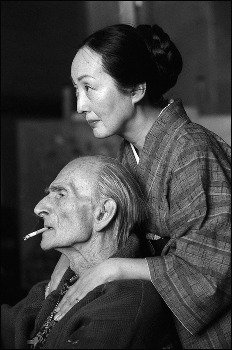Balthus
dal 13/1/2015 al 27/2/2015
Segnalato da
13/1/2015
Balthus
Gagosian Gallery, Paris
On show Balthus's paintings, drawings, and photographs. Balthus was the reclusive painter of charged and disquieting narrative scenes, whose inspirative sources and embrace of exquisitely rigorous technique reach back to the early Renaissance, though with a subversive modern twist.

'From time to time, amidst all the trials and errors, it happens: I recognize what I was looking for. All of a sudden the vision that pre-existed incarnates itself, more or less intuitively and more or less precisely. The dream and the reality are superimposed and made one.' Balthus
Following the initial presentation of “Balthus: The Last Studies” at Gagosian New York at the time of the Metropolitan Museum's retrospective “Balthus: Cats and Girls” in 2013, Gagosian Paris is pleased to announce a career-spanning exhibition of Balthus’s paintings, drawings, and photographs. Prepared in collaboration with artist’s estate, this will be the first exhibition of his work in Paris since the 1983–84 retrospective at the Centre Georges Pompidou.
Balthus was the reclusive painter of charged and disquieting narrative scenes, whose inspirative sources and embrace of exquisitely rigorous technique reach back to the early Renaissance, though with a subversive modern twist. Working independently of avant-garde movements such as Surrealism, he turned to antecedents including Piero della Francesca and Gustave Courbet, appropriating their techniques to depict the physical and psychic struggles of adolescence. Casting viewers as voyeurs of pubescent female subjects brooding with uneasy dreams, he scandalized Parisian audiences with his first gallery exhibition in 1934. In his interior portraits, street scenes, and landscapes of the next seventy years, Balthus cultivated a self-taught classicism as a framework for more enigmatic artistic investigations.
Early ink studies of Paris streets and passersby demonstrate the evolution of what Balthus described as his “timeless realism.” His signature dramatic lighting and muted palette are already evident in the oil paintings Portrait of Pierre Leyris (1932–33), a depiction of the young translator lighting a cigarette after dinner; and Young Girl in Amazonian Costume (1932), shown in his notorious debut at Galerie Pierre two years later. A 1947 study in oil on board for the key large-scale painting The Card Game (1948–50) portrays two girls in modern dress, but rendered with a geometrical order more typical of the Renaissance.
Balthus was appointed director of the French Academy in Rome in 1961, and acquired a medieval castle near Viterbo, an hour’s drive north of the city, in 1970. In watercolors produced over the next several years, he continuously depicted the nearby ruins of a watchtower situated on a steep cliff over a densely wooded ravine, adjusting his palette with the seasons. In the last decade of his life, when physical frailty made it all but impossible for him to draw, he discovered the Polaroid camera—a surprising turn for one who had remained so defiantly aloof from many of the technical innovations of his own time. With it he began making extensive instant photographic “sketches” for his paintings, which were often many years in the making. During this time, his artistic energies and attention were reserved largely for his last model Anna. She posed for him every Wednesday for eight years in the same room with the same curtain, the same chaise longue, the same window in changing light conditions, the same bucolic mountain scenery looming beyond; this enduring scene provided the subject for his final painting, Girl with a Mandolin (2000–01), which remained unfinished at the time of his death.
Image: Balthus and his wife Setsuko, Rossinière, Switzerland, 1998. Photo: Raphael Gaillarde/Gamma-Rapho via Getty Images
Press Contact:
Fabien Tison Le Rou, fabien@claudinecolin.com
Opening reception: Wednesday, January 14th, from 6:00 to 8:00 pm
Gagosian Gallery
4 rue de Ponthieu
75008 Paris



